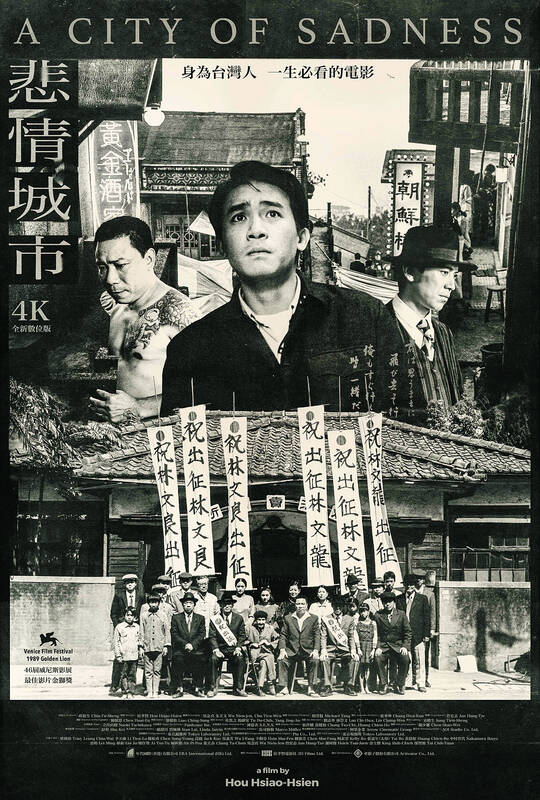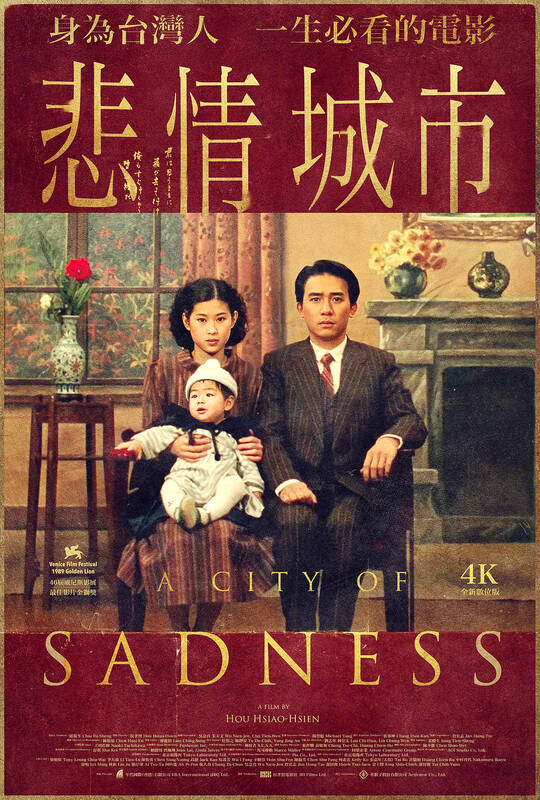A City of Sadness, the 1989 film, directed by the renowned director Hou Hsiao-hsien and based on a story during the 228 Incident, has been re-released after 33 years. With a new poster that reads “A must-see movie for all Taiwanese,” the 4K digital version is being screened in theaters across Taiwan from Feb. 24.
Hou’s A City of Sadness was the winner of the Golden Lion Award for Best Film at the 46th Venice Film Festival in 1989 with its unique visual style and political and historical views, and became the first Taiwanese film to win at one of the three major international film festivals.
It was 10 years after the US cut diplomatic ties with Taiwan in 1979, and Taiwan had become “the orphan of Asia.” During the 1989 Venice Film Festival, due to political interference from China, Taiwan’s national flag was not allowed to be hung outside the Festival venue along with those of other shortlisted films’ countries, leaving Taiwan’s flagpole empty. Despite that, the win made Taiwan’s name and story appear in major media around the world following the success at the film festival.

Photo courtesy of Activator Co. Ltd. 照片:牽猴子股份有限公司提供
A City of Sadness was the first film in Taiwan’s movie history to use synchronized sound technology, Hou’s first movie to tackle historical themes, and was the first film or television work to deal with the 228 Incident after the lifting of martial law in Taiwan in 1987.
The winning of the Golden Lion also laid an unshakable cornerstone for the “Taiwan New Cinema” (or Taiwanese New Wave Cinema) movement, which began in 1982.
It is from A City of Sadness, that Hou, who had already established his signature aesthetics of the “long take,” started to abandon the script during shooting, instead allowing the actors to make their own interpretations. Writer, film producer and entrepreneur Jan Hung-tze recalls that Hou did not show the script to amateur actors, so as to avoid rigid and unnatural acting. Hou described the character’s life and story to the amateur actors on the set, instead of asking them to memorize the dialogue in the script.

Photo courtesy of Activator Co. Ltd. 照片:牽猴子股份有限公司提供
In order to prevent actors from various backgrounds from “acting too hard” in front of the camera, Hou also began to “cheat” his actors, pretending to be rehearsing on the set of the film, but in fact taking advantage of their most relaxed moments to capture the most natural performance. This filming method earned Chen Sung-young the Best Actor of the Golden Horse Awards with his performance in the film.
(Translated by Lin Lee-kai, Taipei Times)
名導侯孝賢執導的「悲情城市」相隔33年重映,電影以二二八事件為背景,新款海報寫上「身為台灣人,一生必看的電影」,4K數位版於2月24日全台上映。
侯孝賢的「悲情城市」憑藉獨特的視覺風格與政治歷史觀點,在1989年摘下第46屆威尼斯影展最佳影片金獅獎,也成為台灣首部在世界三大影展獲獎的國片。
儘管那是1979年台美斷交的10年後,台灣在國際間地位如同「亞細亞的孤兒」,1989年的威尼斯影展,也因中國政治干預,場外懸掛入圍影片國家的旗杆上,原該懸掛中華民國國旗,卻是空空蕩蕩;但獲得金獅獎的《悲情城市》,仍讓台灣的名字、故事,隨著影展捷報,出現在全世界各大媒體。
它是台灣電影史上第一次採用同步錄音技術拍攝的電影,也是侯導第一次挑戰歷史題材,更是台灣在1987年解嚴後,第一部敘述二二八事件的影視作品。
《悲情城市》獲金獅獎,也為從1982年開始的「台灣新電影」運動,奠定了難以撼動的崇高地位。
彼時已確立長鏡頭美學的侯孝賢,也是從《悲情城市》開始,在現場漸漸捨棄劇本,讓演員自己發揮。詹宏志就曾回憶,侯導不給非演員看劇本,以免照本宣科。侯孝賢在拍攝現場是以口頭向非演員描述角色的生平、故事。
為了避免各種背景的演員,在鏡頭前演得太用力,侯孝賢也開始「騙」他的演員,在拍片現場假裝試戲,其實是趁他們最放鬆的情形下,拍下最自然的表現。這個拍法,也讓陳松勇以本片榮獲金馬獎影帝。
(中央社)

In an effort to fight phone scams, British mobile phone company O2 has introduced Daisy, an AI designed to engage phone con artists in time-wasting conversations. Daisy is portrayed as a kindly British granny, exploiting scammers’ tendency to target the elderly. Her voice, based on a real grandmother’s for authenticity, adds to her credibility in the role. “O2” has distributed several dedicated phone numbers online to direct scammers to Daisy instead of actual customers. When Daisy receives a call, she translates the scammers’ spoken words into text and then responds to them accordingly through a text-to-speech system. Remarkably, Daisy

Bilingual Story is a fictionalized account. 雙語故事部分內容純屬虛構。 Emma had reviewed 41 resumes that morning. While the ATS screened out 288 unqualified, she screened for AI slop. She could spot it a mile away. She muttered AI buzzwords like curses under her breath. “Team player.” “Results-driven.” “Stakeholder alignment.” “Leveraging core competencies.” Each resume reeked of AI modeling: a cemetery of cliches, tombstones of personality. AI wasn’t just changing hiring. It was draining the humanity from it. Then she found it: a plain PDF cover letter. No template. No design flourishes. The first line read: “I once tried to automate my

Every May 1, Hawaii comes alive with Lei Day, a festival celebrating the rich culture and spirit of the islands. Initiated in 1927 by the poet Don Blanding, Lei Day began as a tribute to the Hawaiian custom of making and wearing leis. The idea was quickly adopted and officially recognized as a holiday in 1929, and leis have since become a symbol of local pride and cultural preservation. In Hawaiian culture, leis are more than decorative garlands made from flowers, shells or feathers. For Hawaiians, giving a lei is as natural as saying “aloha.” It shows love and

1. 他走出門,左右看一下,就過了馬路。 ˇ He walked outside, looked left and right, and crossed the road. χ He walked outside and looked left and right, crossed the road. 註︰並列連接詞 and 在這句中連接三個述語。一般的結構是 x, y, and z。x and y and z 是加強語氣的結構,x and y, z 則不可以。 2. 他們知道自己的弱點以及如何趕上其他競爭者。 ˇ They saw where their weak points lay and how they could catch up with the other competitors. χ They saw where their weak points lay and how to catch up with the other competitors. 註:and 一般連接同等成分,結構相等的單詞、片語或子句。誤句中 and 的前面是子句,後面是不定詞片語,不能用 and 連接,必須把不定詞片語改為子句,and 前後的結構才相等。 3. 她坐上計程車,直接到機場。 ˇ She took a cab, which took her straight to the airport. ˇ She took a cab and it took her straight